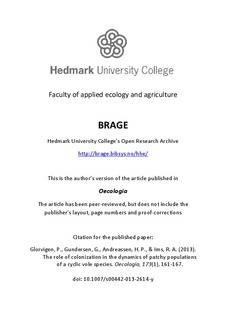The role of colonization in the dynamics of patchy populations of a cyclic vole species
Peer reviewed, Journal article
Permanent lenke
http://hdl.handle.net/11250/134580Utgivelsesdato
2013Metadata
Vis full innførselSamlinger
Originalversjon
Glorvigen, P., Gundersen, G., Andreassen, H. P., & Ims, R. A. (2013). The role of colonization in the dynamics of patchy populations of a cyclic vole species. Oecologia, 173(1), 161-167. doi: 10.1007/s00442-013-2614-ySammendrag
The crash phase of vole populations with cyclic dynamics regularly leads to vast areas of uninhabited habitats. Yet although the capacity for cyclic voles to re-colonize such empty
space is likely to be large and predicted to have become evolved as a distinct life history trait, the processes of colonization and its effect on the spatio-temporal dynamics have been little studied. Here we report from an experiment with root voles (Microtus oeconomus) specifically targeted at quantifying the process of colonization of empty patches from distant source patches and its resultant effect on local vole deme size variation in a patchy landscape. Three experimental factors: habitat quality (1), predation risk (2) and inter-patch distance (3) were employed among 24 habitat patches in a 100x300 m experimental area. The first born cohort in the spring efficiently colonized almost all empty patches irrespective of the degree of patch isolation and predation risk, but dependent on habitat quality. Just after the initial colonization wave the deme sizes in patches of the same quality were underdispersed relative to Poission variance, indicating regulated (density-dependent) settlement. Towards the end of the breeding season local demographic processes acted to smooth out the initial post colonization differences among source and colonization patches, and among patches of initially different quality. However, at this time demographic stochasticity had also given rise to a large (overdispersed) variation in deme sizes that may have contributed to overshadow the effect of other factors. The results of this experiment confirmed our expectation that the space-filling capacity of voles is large. The costs associated with transience appeared to be so low, at least at the spatial scale considered in this experiment, that such costs is not likely to substantially constrain habitat selection and colonization in the increase phase of cyclic patchy populations.
Beskrivelse
This is the postprint version of the article. The published article can be located at www.springerlink.com
